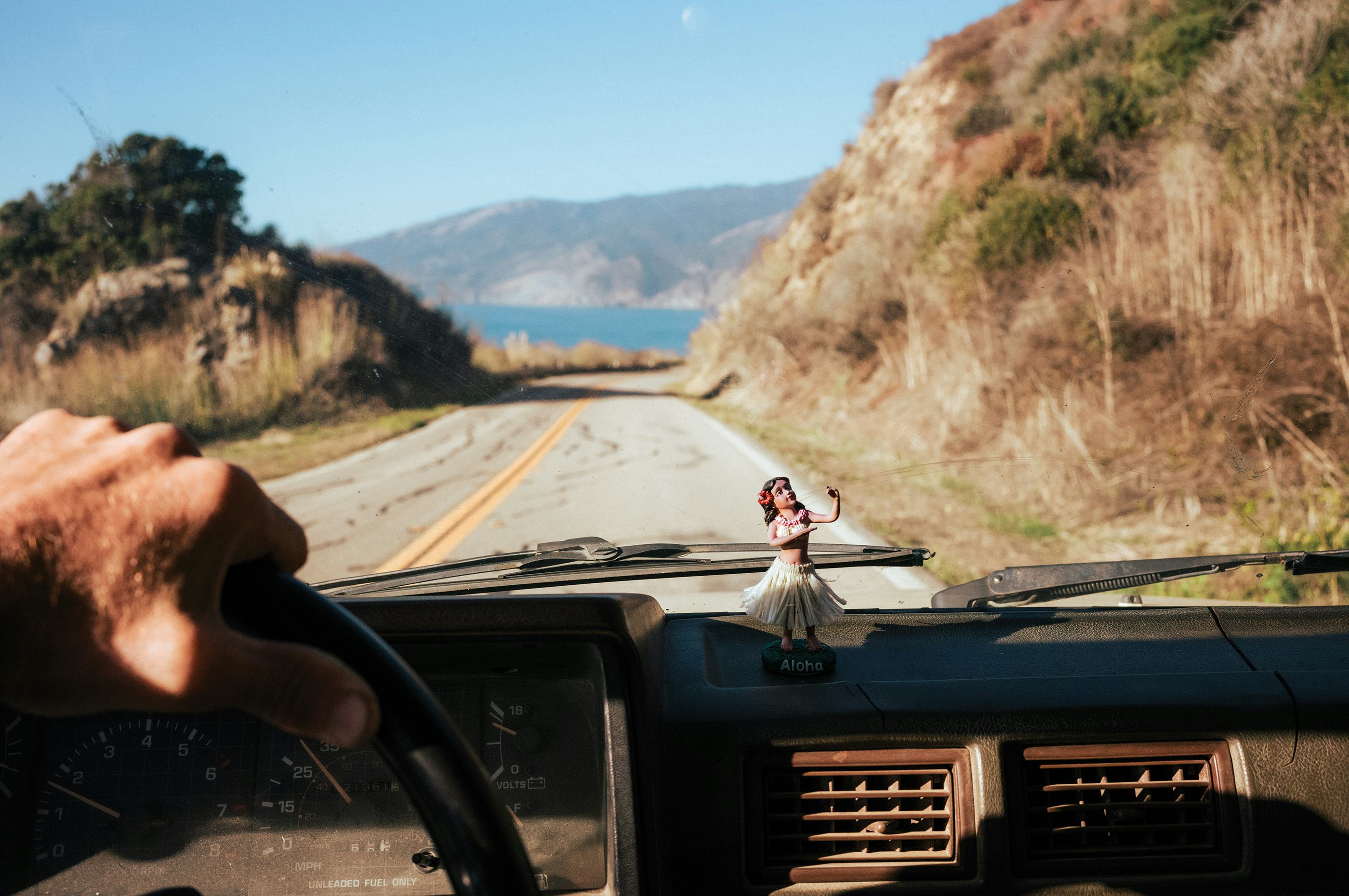
A hula girl momento decorates the dashboard of Jeff's truck.
When Jeff Johnson was a teenager, the surf of the Central Coast inspired an epiphany. Decades later, the photographer, writer and director still seeks out its lessons.
Sweet, calico-patterned dreams: the kind that make perfect sense in sleep, but none at all upon waking. I open my eyes and see razor-sharp stars, the Big Dipper above and Orion’s Belt on the western horizon. My truck is perched on a dirt pullout between Highway 1 and the Pacific. Waves pound the cliff below. The sun won’t be up for another hour.
I sit up on my tailgate and stare at the layered, pastel horizon.
I grew up in the ’70s and ’80s in a small town in the East Bay of San Francisco, and because of this geographical hindrance, I didn’t learn to surf until I got my driver’s license. Thereafter, my friends and I lived for road trips, and our vehicles showed it: We all drove utilitarian trucks or vans or gutted sedans. My first ride was a plain white 1978 Ford utility truck, its lumber racks handy for hauling the wood we “acquired” to build our skate ramps. When I graduated high school, I got a 1984 Toyota 4x4 pickup with a shell and a carpet kit in back. With great mileage and just enough space for two, it seemed like the ultimate road-trip ride.

Surfing, especially back then, was hugely territorial. The worst thing you could do was park a truck plastered with surf stickers someplace along the coast, basically advertising a “secret” spot. You wanted to be low key. So the only sticker I put on my Toyota was a Grateful Dead “Steal Your Face” skull. I wasn’t a Deadhead, but the sticker was a great deterrent for passing surfers, who were typically hippie-averse.
At first, the coastline south of San Francisco was our playground, but soon we ventured farther south, to Big Sur. I remember our first foray. My friends and I hiked to a remote beach break. We made little cobblestone structures to sit in and, well, embarked on various illicit adventures. Instead of surfing, I ended up getting lost in what we later called the Hobbit Forest. We didn’t reconvene until almost dark.

I was a troubled kid, to say the least. Had a hard time with authority. Still do. But that evening, parked along the shoulder of the PCH, I had an epiphany. We were sitting in the back of my Ford, drinking warm Budweisers, eating cold hot dogs, watching an impossibly slow sunset. Everything was bathed in golden light: the mountains, the surf, the rivers, the valleys that connect it all. My revelation was simple: This life along the coast was no place for dark preoccupations. Or at least, I felt, no place for mohawks and leather jackets. So I changed my ways.
Now, some 40 years later, I am back on the side of the PCH. The world has changed dramatically, and so have I. But at Big Sur, and for long stretches of the Central Coast on either side of it, nothing has changed.

A few years back, I bought a 1984 Toyota truck from a friend who refitted it with a flatbed, reminiscent of what Australians call a “ute.” It’s my around-town vehicle, helpful for my nonstop yard work. Or maybe it’s just my midlife-crisis ride. It puts me in mind of Robert Kincaid, the fictional photojournalist in The Bridges of Madison County and an inspiration for me; a photographer who kept things simple, driving the Iowa backroads in his Chevy pickup. In the same spirit, I have a simple truck, one surfboard, one camera, and a little cool- er. My only travel companion is a hula doll on the dash, a memento of our stint living in Hawaii.
I find it incredible that, in a state with 40 million people, this coastline between Santa Barbara and San Francisco remains largely undeveloped. Much to the credit of the tenacious environmental activists California is so famous for. Without their efforts, the Central Coast might look like the French Riviera.
I brew a cup of coffee as the sun’s first rays pour over the Santa Lucias. Shafts of light fill each consecutive valley, like angel wings. It’s the same golden light that sent me on my way, around the world and right back here, to this same exact spot, not far from the Hobbit Forest. Looking out at the Pacific, I see corduroy lines marching in from the horizon, shimmering metallic blue. I pack my gear, strap my board to the flatbed and grab my camera, to remember.







